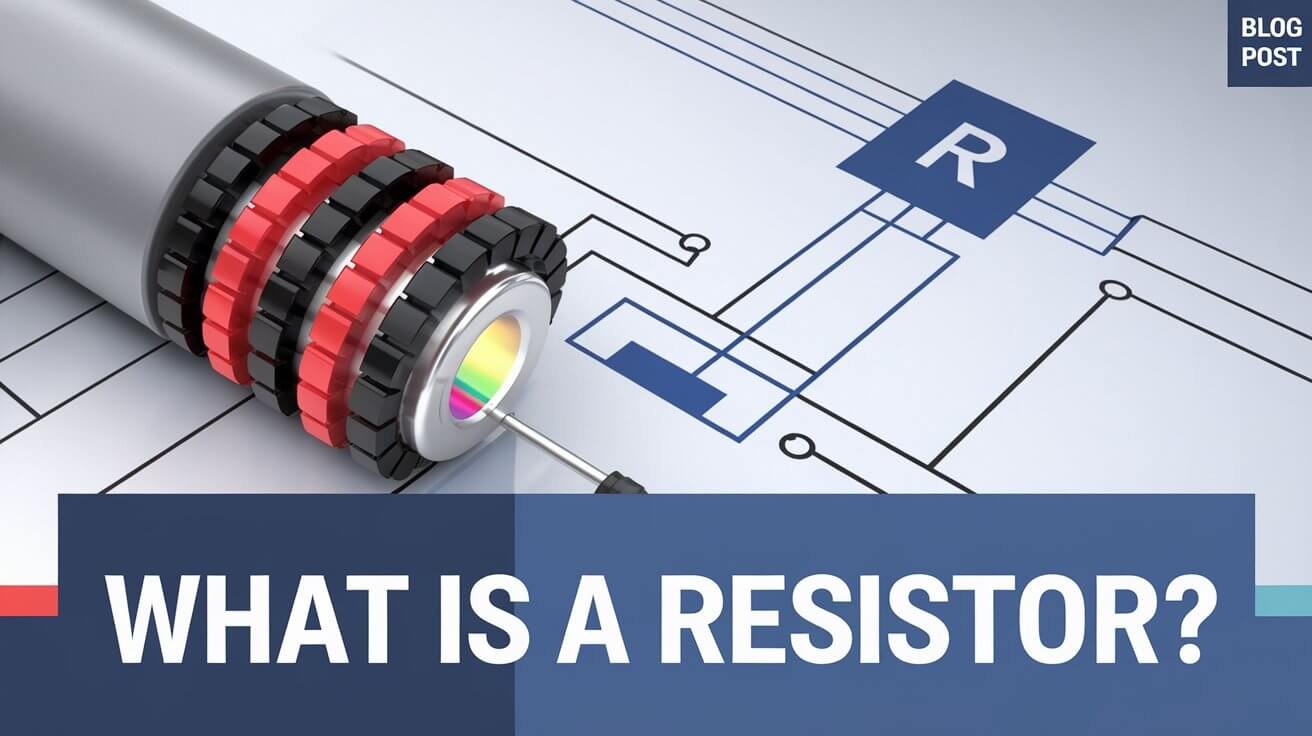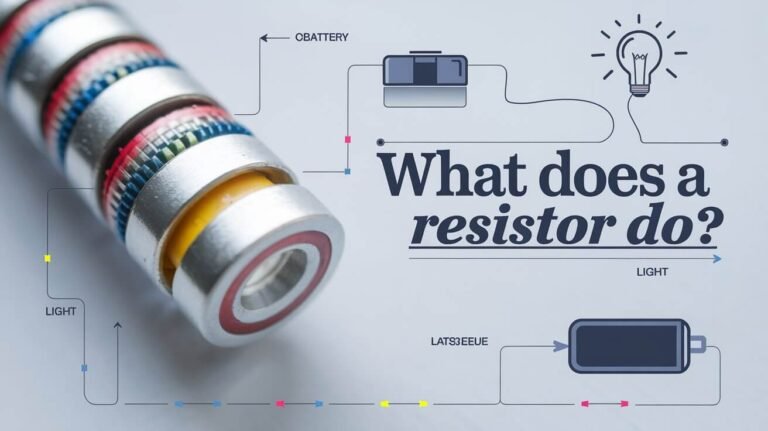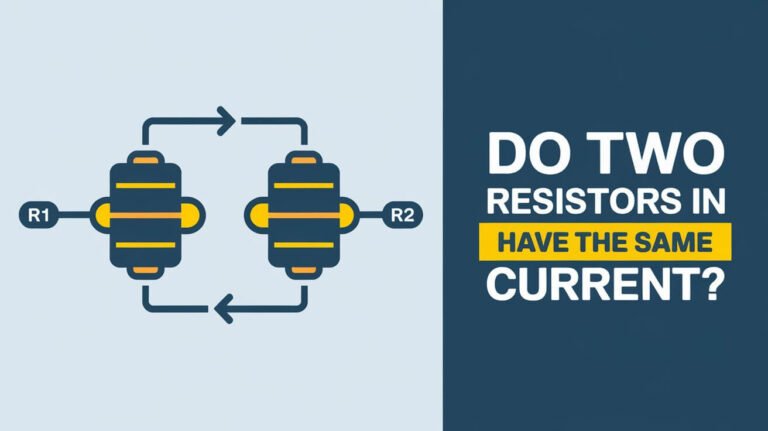
A resistor is a key part of electronic circuits. It helps control how much current flows and keeps the voltage steady. Resistors are used to make sure devices like transistors get the right amount of power.
They come in many sizes, making them very important in electronics. Resistors are rated for how much power they can handle. This is usually 1⁄10, 1⁄8, or 1⁄4 watt for most systems.
Resistors help control voltage and manage current flow. This makes them vital in many electronic circuits. Knowing how resistors work helps us see their importance in devices we use every day.
Basic Function of Resistors in Electronics
Resistors are key in electronic circuits, thanks to Ohm’s law. They help reduce current, adjust signal levels, and divide voltages. They also end transmission lines. Their main job is to control electric current by adding resistance.
In circuits, resistors limit current to protect other parts. Ohm’s law shows how current, voltage, and resistance are linked. This is key to understanding resistors’ role. They also help create specific voltage levels, which is vital for many devices.
Current Control Mechanisms
Resistors manage current flow by adding resistance. This prevents damage to other parts. Ohm’s law explains how current, voltage, and resistance are connected.
Voltage Division Properties
Resistors are used to split voltages, creating specific levels in circuits. This is important for many devices. They achieve this by being in series or parallel.
Heat Generation Process
Resistors turn electrical energy into heat. This is due to power dissipation. Managing heat is key to avoid damage and extend lifespan.
Knowing how resistors work is essential for circuit design. They control current, divide voltages, and generate heat. Their role is based on Ohm’s law, making them critical in circuit design.
Physical Components of Resistors
Resistors come in many forms, but the most common is the carbon-composition type. The materials used in resistors greatly affect their performance. These materials include carbon, metal films, and wire-wound types.
The terminals of a resistor are key for connecting to circuits. The type of terminal used can influence how well the resistor works, even at high frequencies. The packaging of resistors also matters. It can be through-hole or surface-mount, affecting the resistor’s reliability.
Some common characteristics of resistors include:
- Resistive material: carbon, metal films, wire-wound
- Terminals: variety of types, including wire leads and surface-mount
- Packaging: through-hole, surface-mount, and others
Knowing about the physical parts of resistors is key to picking the right one. By looking at the resistive material, terminals, and packaging, designers can make sure their circuits work well. Each resistor type has its own strengths, like power handling and frequency response, which are important for the best performance.
| Resistor Type | Resistive Material | Terminals | Packaging |
|---|---|---|---|
| Carbon-Composition | Carbon | Wire leads | Through-hole |
| Metal Film | Metal | Surface-mount | Surface-mount |
| Wire-Wound | Wire | Wire leads | Through-hole |
Color Coding System on Resistors
Resistors use a color coding system for easy identification. This system has color bands that show the resistance value and tolerance. These bands help figure out the resistor’s nominal resistance and tolerance percentage.
The number of color bands changes with the tolerance. Resistors with ±5% or ±10% tolerance have 4 bands. Those with ±1% or ±2% tolerance have 5 bands. The tolerance ratings are: Brown = 1%, Red = 2%, Gold = 5%, and Silver = 10%.
Primary Color Band Meanings
The primary bands show the resistor’s resistance value. Each color has a specific meaning based on the value and tolerance. For example, the first band is the first digit, and the second is the second digit.
Tolerance Band Interpretation
The tolerance band shows how accurate the resistor’s value is. It’s usually the last band. It helps find the minimum and maximum resistance values.
To find the minimum value, multiply the nominal value by the tolerance and subtract it. To find the maximum value, multiply the nominal value by the tolerance and add it.
Temperature Coefficient Indicators
Some resistors have a sixth band for the temperature coefficient. This band shows how the resistor value might change with temperature. It’s key in applications where temperature affects the resistor’s performance.
| Tolerance | Number of Bands | Color Code Values |
|---|---|---|
| ±5% or ±10% | 4 | Brown = 1%, Red = 2%, Gold = 5%, Silver = 10% |
| ±1% or ±2% | 5 | Brown = 1%, Red = 2%, Gold = 5%, Silver = 10% |
What Is A Resistor: Core Principles
A resistor is a part that slows down electric current flow. This slowing down is called electrical resistance. Ohm’s law explains how voltage, current, and resistance are connected: V = IR. This law is key to understanding how resistors function and their role in circuits.
Electrical resistance is linked to conductivity and resistivity. Conductivity is how well a material carries electric current. Resistivity is how much a material resists electric current flow. Knowing these concepts is vital for creating electronic circuits.
Several factors influence a resistor’s performance. The material used, the temperature coefficient, and the power rating are important. The material affects how well the resistor conducts or resists current. The temperature coefficient shows how resistance changes with temperature. The power rating tells us the maximum power the resistor can handle safely.
Here are some key points to consider when working with resistors:
- Resistance is measured in ohms (Ω), showing how much a resistor slows down electric current.
- Resistance values can vary a lot, from very small to very large ohms, depending on the use.
- Tolerance in resistors shows how much the actual value can differ from the stated value, as a percentage.
Knowing the basics of resistors is critical for making electronic circuits. By looking at the material, temperature coefficient, and power rating, engineers can make circuits that work well and safely.
Common Resistor Types
Resistors are key in electronic circuits. They come in many types for different uses. The most common is the fixed resistor, whose resistance changes little with temperature or voltage.
Fixed resistors include carbon film, wirewound, and metal film types. Variable resistors, like potentiometers, adjust circuit elements. They can also sense changes in heat, light, or chemicals.
Fixed Resistors
Fixed resistors are the most common. They range from 1 ohm to 25 mega ohms. Their power ratings vary from ¼ watt to 5 watts.
Carbon film resistors work well over a wide range. Metal film resistors are stable and quiet, with a low temperature coefficient.
Variable Resistors
Variable resistors, like potentiometers, can handle up to 10 mega ohms. They’re used for adjusting voltage and resistance. They come in up to 5 watt power ratings.
Special Purpose Resistors
Special resistors, like thermistors and photoresistors, change with temperature and light. They’re used for sensing environmental changes. Wirewound resistors are good for low resistance values and have a +/- 1% tolerance.
Power Ratings and Specifications
Resistors are rated by their maximum power dissipation, shown as a number followed by “W”. This wattage rating tells us how much power a resistor can handle safely. For instance, a 1/2 W resistor can handle up to 0.5 watts.
Several things affect a resistor’s power rating. These include its size, material, and how it’s mounted. Bigger resistors can handle more power because they have more surface area to cool down. The maximum voltage a resistor can handle is also key, mainly in high-voltage circuits. The temperature coefficient of a resistor also matters, as it affects how much heat is generated.
Here are some common power ratings for resistors:
- 1/8 W
- 1/4 W
- 1/2 W
- 1 W
- 2 W
These ratings are in watts, with bigger resistors able to handle more power. Higher wattage ratings mean higher costs. When picking a resistor, think about its wattage rating, maximum voltage, and temperature coefficient. This ensures it can safely handle the power and meet your needs.
Circuit Design Applications
Resistors are key parts of electrical networks and electronic circuits. They are found in many electronic devices. Let’s look at how resistors are used in circuit design, like in voltage dividers, LED current control, and digital logic circuits.
Resistors help create certain voltage levels, which is vital in voltage division circuits. They also limit current, protecting sensitive parts like LEDs. In digital logic circuits, resistors help set up pull-up and pull-down configurations, which are critical for circuit function.
Voltage Division Circuits
Voltage dividers are used to make specific voltage levels. They are made of two resistors in series. The voltage across each resistor depends on its resistance. This makes voltage dividers useful for creating specific voltage levels, often used in LED current control.
Current Limiting Solutions
Resistors can limit current, protecting sensitive parts like LEDs from damage. This is key in applications where high currents could harm components. By controlling current with resistors, designers ensure their circuits work safely and efficiently.
Pull-up and Pull-down Configurations
In digital logic circuits, resistors help create pull-up and pull-down configurations. These are essential for the circuit to work right. They are used in many digital logic circuits. Resistors in these configurations help make digital circuits reliable and efficient.
| Component | Function | Application |
|---|---|---|
| Resistor | Voltage division | LED current control |
| Resistor | Current limiting | Digital logic circuits |
| Resistor | Pull-up and pull-down configurations | Digital logic circuits |
Resistors are essential in circuit design, with many uses. They help in voltage dividers, current limiting, and pull-up and pull-down configurations. This makes electronic circuits reliable and efficient.
Temperature Effects and Reliability
Temperature greatly affects how well resistors work. In electrical circuits, heat can make a conductor’s resistance go up. This is because atoms move more when it’s hotter.
To keep resistors stable, it’s important to pick materials that don’t change much with temperature. Metals like Manganin or Constantan are good for this. They don’t change resistance much when the temperature changes.
Understanding how temperature affects resistors is key for precise measurements. This ensures that electrical systems work well and give accurate results.
To deal with temperature changes, special circuits can be used. These circuits adjust for temperature changes in real-time. This helps keep the measurements accurate and reliable.
| Material | Thermal Coefficient | Common Applications |
|---|---|---|
| Manganin | Low | Current Shunt Resistors |
| Constantan | Low | Current Shunt Resistors |
| Copper | High | General Electrical Wiring |
Resistance Measurement Methods
Measuring resistance is key to understanding electronic circuits. We use tools like digital multimeters and follow specific guidelines. It’s important to test resistance correctly to get accurate results.
When measuring circuits, always turn off the power first. Make sure the circuit is safe to test. Wearing protective gear is also a must to avoid injury.
Digital Multimeter Techniques
A digital multimeter (DMM) is a popular tool for measuring resistance. Before starting, check the probes for any issues. The DMM should show zero or a small number when the probes touch, and OL or I when they don’t.
Ohmmeter Usage Guidelines
Using an ohmmeter requires following the manufacturer’s instructions. Make sure to isolate the component and use the right method. This could be the two-terminal or four-terminal method.
Important factors to consider during resistance measurements include:
- Electromotive force
- Thermal noise
- Leakage current
- Dielectric absorption
- Friction noise
- External noise
Following these guidelines and choosing the right tool, you can get precise resistance measurements.
| Instrument | Method | Factors Affecting Measurement |
|---|---|---|
| Analog multimeter | Two-terminal measurement | Electromotive force, thermal noise |
| Digital multimeter | Four-terminal measurement | Leakage current, dielectric absorption |
Troubleshooting Resistor Problems
Resistors are key in electronic circuits. Their failure can cause big problems. Knowing how resistors fail helps fix circuits. Common failures are open circuits and value changes due to too much power.
When a resistor fails, it can damage the circuit board or nearby parts. It might even start a fire.
To find resistor problems, use the right tools. Check the resistor’s value and look for physical damage. If it’s bad, replace it with a part that matches its value and power rating.
Choosing the right resistor and soldering it correctly is important. Make sure the new resistor can handle the power without burning out. This way, your circuits will work right.
Resistors come in many values like 10, 12, 15, and 82 ohms. When picking a new one, know the differences between carbon, carbon-film, metal-film, and wirewound resistors. This helps find the perfect match for your circuit.
Final Words
In this article, we’ve looked at how resistors are key in electronic design. They are vital for controlling current and regulating voltage. This makes sure electronic devices work well.
Resistors are everywhere, from simple tools to complex security systems. They are essential in the world of electronics.
Knowing how resistors work is important for anyone in electronic design. It’s key for designing circuits or fixing existing ones. Learning about resistors can really help you.
As technology gets better, so will the role of resistors. New materials and ways of making resistors will improve their performance. Staying up-to-date will keep your skills sharp for the future.
Frequent Questions
What is a resistor?
A resistor is a key part in electronics. It helps control the flow of electric current and voltage in circuits.
What are the primary functions of resistors in electronics?
Resistors have three main roles in circuits. They control current, divide voltage, and generate heat.
What are the different materials used in resistor construction?
Resistors are made from materials like carbon, metal films, and wirewound. Each has its own uses and features.
How do I read the color coding on a resistor?
The color bands on a resistor show its value, tolerance, and temperature coefficient. They help you understand the resistor’s details.
What is the concept of electrical resistance?
Electrical resistance is how much a circuit opposes electric current. It’s explained by Ohm’s law, which links voltage, current, and resistance.
What are the different types of resistors?
There are fixed, variable, and special-purpose resistors. Each type has its own features and uses.
What are the important specifications to consider when selecting a resistor?
When picking a resistor, look at its power rating, maximum voltage, and temperature coefficient. These affect its performance and reliability.
How can resistors be used in circuit design?
Resistors are vital in voltage division, current limiting, and digital logic circuits. They help manage electrical signals.
How does temperature affect resistor performance and reliability?
Temperature can change a resistor’s accuracy and stability. This is important in applications where temperature matters.
What are the best practices for measuring resistance?
Use a digital multimeter correctly and follow guidelines for measuring resistance in circuits. This ensures accurate readings.
How can I troubleshoot issues related to resistors in a circuit?
To fix resistor problems, know common failure modes, diagnose issues, and replace resistors correctly. This helps solve circuit problems.




